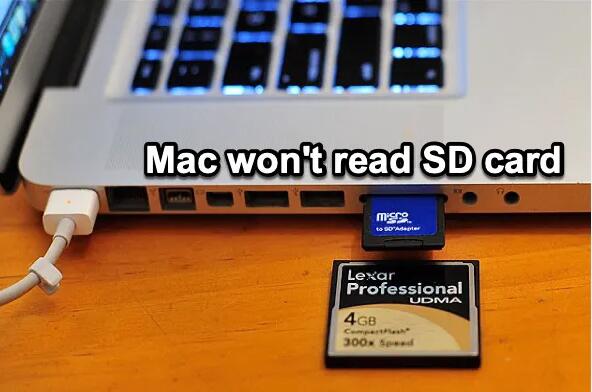1. Initial Checks
a. Physical Inspection
Card Reader: Ensure your SD card reader or slot is functioning properly. Test it with another card if possible.
SD Card: Inspect the SD card for visible damage. Check for any cracks, dirt, or debris on the card’s contacts.
b. Card Compatibility
SD Format: Ensure your SD card is not in a format that macOS does not support, such as SDXC cards in older Mac models with outdated drivers.
File System: Check if the card is formatted in a file system macOS supports, such as FAT32. exFAT, or APFS.

2. System Checks
a. Restart Your Mac
Simple Restart: Sometimes, a simple restart can resolve connectivity issues.
b. Update macOS
System Update: Make sure macOS is up-to-date. Sometimes, updates include new drivers or fixes for hardware compatibility issues.
c. Check Disk Utility
Open Disk Utility: Go to Applications > Utilities > Disk Utility.
Locate the SD Card: See if the SD card appears in the sidebar. If it does, but is not mounted, select it and click Mount.
3. Troubleshooting
a. Verify and Repair Disk
Run First Aid: In Disk Utility, select the SD card and click on First Aid. This tool will check for and attempt to repair file system errors.
b. Use Terminal
Identify Disk: Open Terminal from Applications > Utilities and type diskutil list to see if your SD card is recognized.
Mount Disk: If recognized, use the command sudo diskutil mount /dev/diskX (replace diskX with your SD card identifier) to try mounting the disk manually.
4. Data Recovery
a. Using Data Recovery Software
Choose Software: Select a reputable data recovery tool compatible with macOS. Popular options include:
Disk Drill
Data Rescue
EaseUS Data Recovery Wizard
Wondershare Recoverit
Install and Scan: Install the software and perform a scan on your SD card. Follow the instructions to recover any detected files.
b. Using Photo Recovery Tools
Dedicated Photo Recovery: For SD cards used primarily for photos, tools like PhotoRec or Recoverit Photo Recovery can be more effective.
5. Advanced Troubleshooting
a. Check for Hardware Issues
Try Another Reader: Test your SD card in a different card reader or device to rule out hardware issues.
Test on Another Computer: If possible, test the card on a different computer to see if the issue persists.
b. Professional Data Recovery Services
Consider Professional Help: If you have valuable data and none of the above steps work, consider contacting a professional data recovery service. They can often recover data from severely damaged or corrupted cards.
6. Preventive Measures
a. Regular Backups
Backup Data: Regularly backup important data to prevent loss in case of SD card failure.
Use Reliable Hardware: Invest in high-quality SD cards and card readers to reduce the likelihood of hardware issues.
b. Safe Removal
Eject Properly: Always use the “Eject” function in macOS before removing the SD card to avoid file system corruption.
7. Conclusion
Troubleshooting an unreadable SD card on a Mac involves checking physical connections, verifying system settings, using built-in tools, and possibly relying on data recovery software or professional services. Regular maintenance and proper handling can help prevent future issues.
About us and this blog
Panda Assistant is built on the latest data recovery algorithms, ensuring that no file is too damaged, too lost, or too corrupted to be recovered.
Request a free quote
We believe that data recovery shouldn’t be a daunting task. That’s why we’ve designed Panda Assistant to be as easy to use as it is powerful. With a few clicks, you can initiate a scan, preview recoverable files, and restore your data all within a matter of minutes.

 Try lt Free
Try lt Free Recovery success rate of up to
Recovery success rate of up to









